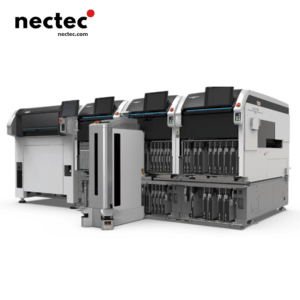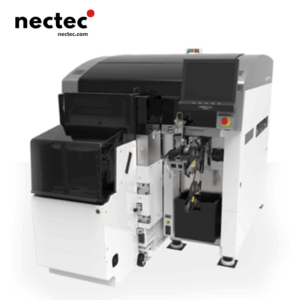W erze, w której wydajność i precyzja produkcji decydują o sukcesie linii produkcyjnych, znaczenie automatyzacji jest nie do przecenienia. Wśród różnych postępów w technologii produkcji, maszyny typu pick and place stały się niezbędnymi narzędziami, szczególnie w montażu komponentów takich jak nakrętki teowe. Niniejszy artykuł poświęcony jest temu, czym są maszyny typu pick and place, jaka jest ich funkcjonalność i w jaki sposób rewolucjonizują one integrację nakrętek teowych w różnych zastosowaniach.
Zrozumienie maszyn typu Pick and Place
Maszyny typu pick and place to zautomatyzowane systemy zaprojektowane do pobierania komponentów z wyznaczonej lokalizacji i dokładnego umieszczania ich na powierzchni produkcyjnej. Maszyny te wykorzystują kombinację zrobotyzowanych ramion, przyssawek i zaawansowanych czujników do wykonywania zadań z niezrównaną szybkością i precyzją.
Wszechstronność maszyn typu pick and place pozwala im na obsługę różnych komponentów, dzięki czemu idealnie nadają się do montażu produktów, od prostych artykułów gospodarstwa domowego po skomplikowane urządzenia elektroniczne. Jeśli chodzi o nakrętki teowe - specjalistyczne elementy złączne szeroko stosowane w obróbce drewna i metalu do tworzenia mocnych, niezawodnych połączeń - maszyny typu pick and place demonstrują swoją wartość poprzez zwiększoną produktywność i zwiększoną dokładność montażu.
Jak działają maszyny Pick and Place
Operacyjny przepływ pracy maszyny typu pick and place obejmuje zazwyczaj kilka kluczowych procesów:
- Systemy wizyjne: Maszyny te często zawierają zaawansowane systemy wizyjne, które identyfikują i lokalizują komponenty na linii produkcyjnej. Zdolność ta ma kluczowe znaczenie dla zarządzania nakrętkami teowymi, które mogą mieć różne rozmiary i profile.
- Mechanizm wyboru: Po zidentyfikowaniu, mechanizm chwytaka łączy się z nakrętką teową, używając przyssawek lub chwytaków mechanicznych, aby bezpiecznie chwycić element bez powodowania jakichkolwiek uszkodzeń.
- Umieszczenie: Po pobraniu komponentu ramię robota przenosi go do wyznaczonego miejsca, zapewniając dokładne pozycjonowanie i wyrównanie.
Rola nakrętek teowych w produkcji
Nakrętki teowe służą jako niezawodny punkt połączenia, szczególnie w zastosowaniach wymagających regulowanych komponentów, takich jak montaż mebli i obróbka CNC. Ich konstrukcja zapewnia wytrzymałość i elastyczność, ale ręczny montaż może być czasochłonny i pracochłonny.
Dzięki zastosowaniu maszyn typu "pick and place" producenci mogą drastycznie skrócić czas i koszty pracy związane z nakładaniem nakrętek T-nut. Automatyzacja ta eliminuje również niespójności związane z ręczną obsługą, prowadząc do wyższych standardów jakości produktu.
Korzyści z używania maszyn typu Pick and Place do nakrętek teowych
Integracja maszyn typu "pick and place" z procesem produkcji nakrętek teowych przynosi wiele korzyści:
1. Zwiększona szybkość i wydajność
Dzięki możliwości ciągłej pracy, maszyny typu pick and place znacznie zwiększają prędkość linii produkcyjnych. Mogą one szybko ładować i pozycjonować nakrętki teowe przy minimalnych przestojach, co przekłada się na wyższą wydajność bez utraty jakości.
2. Zwiększona precyzja
Precyzja ma kluczowe znaczenie podczas pracy z nakrętkami teowymi, zwłaszcza gdy są one częścią zespołu, który wymaga dokładnego dopasowania. Zautomatyzowane maszyny mogą umieszczać te komponenty z precyzyjnymi tolerancjami, które byłyby trudne do osiągnięcia ręcznie.
3. Niższe koszty pracy
Automatyzacja zmniejsza zależność od pracy fizycznej, umożliwiając producentom przydzielenie siły roboczej do zadań wymagających ludzkiego nadzoru i kreatywności. Ta zmiana może z czasem prowadzić do znacznych oszczędności kosztów, ponieważ na liniach produkcyjnych potrzeba mniej pracowników.
4. Poprawa bezpieczeństwa
Dzięki zmniejszeniu ilości ręcznego przenoszenia i montażu, maszyny typu pick and place zwiększają również bezpieczeństwo w miejscu pracy. Mniejsza liczba pracowników narażonych na potencjalnie niebezpieczne zadania skutkuje niższym ryzykiem wypadków i urazów.
Studia przypadków: Pomyślne wdrożenie maszyn typu Pick and Place dla nakrętek teowych
Studium przypadku 1: Producent mebli
Wiodący producent mebli wdrożył maszyny typu pick and place, aby zautomatyzować proces montażu mebli modułowych wykorzystujących nakrętki teowe. Integracja tego systemu zaowocowała wzrostem prędkości produkcji o 50% i zmniejszeniem kosztów pracy o około 30%. Lepsze zapewnienie jakości doprowadziło również do zmniejszenia liczby zwrotów produktów z powodu błędów montażowych.
Studium przypadku 2: Dostawca części do maszyn CNC
Dostawca części do maszyn CNC stanął w obliczu wyzwań związanych z szybkim montażem złożonych konstrukcji wykorzystujących wiele nakrętek teowych. Firma zastosowała rozwiązanie pick and place, które nie tylko poprawiło szybkość montażu, ale także zwiększyło dokładność umieszczania elementów dzięki precyzyjnie dostrojonym możliwościom maszyny. W rezultacie odnotowano wzrost przepustowości o 40% i większe zadowolenie klientów dzięki skróceniu czasu realizacji zamówień.
Przyszłość maszyn typu "podnieś i umieść" w produkcji
W miarę postępu technologicznego, maszyny typu pick and place stają się coraz inteligentniejsze, wykorzystując sztuczną inteligencję i uczenie maszynowe w celu ciągłej optymalizacji ich wydajności. Przyszłe ulepszenia mogą obejmować:
- Optymalizacja oparta na sztucznej inteligencji: Sztuczna inteligencja może analizować dane produkcyjne w celu udoskonalenia wydajności maszyn i wcześniejszego zaspokojenia potrzeb konserwacyjnych, utrzymując płynność operacji.
- Roboty współpracujące (Coboty): Integracja cobotów może dodatkowo ułatwić współpracę człowieka z robotem, pozwalając pracownikom na nadzorowanie wysiłków związanych z automatyzacją przy jednoczesnym skupieniu się na bardziej złożonych i kreatywnych zadaniach.
- Integracja IoT: Internet rzeczy (IoT) umożliwi monitorowanie i gromadzenie danych w czasie rzeczywistym, prowadząc do lepszego podejmowania decyzji i wydajności operacyjnej.
Ponieważ branże coraz bardziej doceniają wartość automatyzacji, znaczenie maszyn typu pick and place dla komponentów takich jak nakrętki teowe będzie nadal rosło. Przyjmując te technologie, producenci mogą utrzymać przewagę konkurencyjną na szybko zmieniającym się rynku, zapewniając, że są dobrze przygotowani, aby sprostać wymaganiom przyszłości.








